Tri-Doping of Sol–Gel Synthesized Garnet-Type Oxide Solid-State Electrolyte
Abstract
1. Introduction
2. Materials and Methods
2.1. LLZO Solid-State Electrolyte Synthesis Using Sol–Gel Technique
2.2. Characterization of Solid-State Electrolyte Materials
3. Results and Discussion
3.1. Mono-Doped LLZO Solid-State Electrolyte
3.2. Co- and Tri-Doped LLZO Solid-State Electrolyte
3.3. Effect of Rb Content on Properties of Tri-Doped LLZO Ceramics
4. Conclusions
Author Contributions
Funding
Conflicts of Interest
References
- Zubi, G.; Dufo-López, R.; Carvalho, M.; Pasaoglu, G. The lithium-ion battery: State of the art and future perspectives. Renew. Sustain. Energy Rev. 2018, 89, 292–308. [Google Scholar] [CrossRef]
- Zhang, Q.; Li, C.; Wu, Y. Analysis of research and development trend of the battery technology in electric vehicle with the perspective of patent. Energy Procedia 2017, 105, 4274–4280. [Google Scholar] [CrossRef]
- Wu, F.; Maier, J.; Yu, Y. Guidelines and trends for next-generation rechargeable lithium and lithium-ion batteries. Chem. Soc. Rev. 2020, 49, 1569–1614. [Google Scholar] [CrossRef]
- Tarascon, J.-M.; Armand, M. Issues and challenges facing rechargeable lithium batteries. Nature 2001, 414, 359–367. [Google Scholar] [CrossRef]
- Wen, J.; Yu, Y.; Chen, C. A review on lithium-ion batteries safety issues: Existing problems and possible solutions. Mater. Express 2012, 2, 197–212. [Google Scholar] [CrossRef]
- Spotnitz, R.; Franklin, J. Abuse behavior of high-power, lithium-ion cells. J. Power Sources 2003, 113, 81–100. [Google Scholar] [CrossRef]
- Takada, K. Progress and prospective of solid-state lithium batteries. Acta Mater. 2013, 61, 759–770. [Google Scholar] [CrossRef]
- Wang, Y.; Richards, W.D.; Ong, S.P.; Miara, L.J.; Kim, J.C.; Mo, Y.; Ceder, G. Design principles for solid-state lithium superionic conductors. Nat. Mater. 2015, 14, 1026–1031. [Google Scholar] [CrossRef]
- Yoshima, K.; Harada, Y.; Takami, N. Thin hybrid electrolyte based on garnet-type lithium-ion conductor Li7La3Zr2O12 for 12 V-class bipolar batteries. J. Power Sources 2016, 302, 283–290. [Google Scholar] [CrossRef]
- Bachman, J.C.; Muy, S.; Grimaud, A.; Chang, H.-H.; Pour, N.; Lux, S.F.; Paschos, O.; Maglia, F.; Lupart, S.; Lamp, P.; et al. Inorganic solid-state electrolytes for lithium batteries: Mechanisms and properties governing ion conduction. Chem. Rev. 2016, 116, 140–162. [Google Scholar] [CrossRef]
- Famprikis, T.; Canepa, P.; Dawson, J.A.; Islam, M.S.; Masquelier, C. Fundamentals of inorganic solid-state electrolytes for batteries. Nat. Mater. 2019, 18, 1278–1291. [Google Scholar] [CrossRef] [PubMed]
- Zhu, Z.; Hong, M.; Guo, D.; Shi, J.; Tao, Z.; Chen, J. All-solid-state lithium organic battery with composite polymer electrolyte and pillar[5]quinone cathode. J. Am. Chem. Soc. 2014, 136, 16461–16464. [Google Scholar] [CrossRef]
- Lalère, F.; Leriche, J.B.; Courty, M.; Boulineau, S.; Viallet, V.; Masquelier, C.; Seznec, V. An all-solid state NASICON sodium battery operating at 200 °C. J. Power Sources 2014, 247, 975–980. [Google Scholar] [CrossRef]
- Inada, T.; Kobayashi, T.; Sonoyama, N.; Yamada, A.; Kondo, S.; Nagao, M.; Kanno, R. All solid-state sheet battery using lithium inorganic solid electrolyte, thio-LISICON. J. Power Sources 2009, 194, 1085–1088. [Google Scholar] [CrossRef]
- Li, Y.; Xu, H.; Chien, P.-H.; Wu, N.; Xin, S.; Xue, L.; Park, K.; Hu, Y.-Y.; Goodenough, J.B. A perovskite electrolyte that is stable in moist air for lithium-ion batteries. Angew. Chem. Int. Ed. 2018, 57, 8587–8591. [Google Scholar] [CrossRef]
- Sakuda, A.; Hayashi, A.; Tatsumisago, M. Sulfide solid electrolyte with favorable mechanical property for all-solid-state lithium battery. Sci. Rep. 2013, 3, 2261. [Google Scholar] [CrossRef] [PubMed]
- Thangadurai, V.; Kaack, H.; Weppner, W.J.F. Novel fast lithium ion conduction in garnet-type Li5La3M2O12 (M = Nb, Ta). J. Am. Ceram. Soc. 2003, 86, 437–440. [Google Scholar] [CrossRef]
- Afyon, S.; Krumeich, F.; Rupp, J.L.M. A shortcut to garnet-type fast Li-ion conductors for all-solid state batteries. J. Mater. Chem. A 2015, 3, 18636–18648. [Google Scholar] [CrossRef]
- Richards, W.D.; Miara, L.J.; Wang, Y.; Kim, J.C.; Ceder, G. Interface stability in solid-state batteries. Chem. Mater. 2016, 28, 266–273. [Google Scholar] [CrossRef]
- Zhang, Y.; Chen, F.; Rong, T.; Shen, Q.; Zhang, L. Field assisted sintering of dense Al-substituted cubic phase Li7La3Zr2O12 solid electrolytes. J. Power Sources 2014, 268, 960–964. [Google Scholar] [CrossRef]
- Jalem, R.; Yamamoto, Y.; Shiiba, H.; Nakayama, M.; Munakata, H.; Kasuga, T.; Kanamura, K. Concerted migration mechanism in the Li ion dynamics of garnet-type Li7La3Zr2O12. Chem. Mater. 2013, 25, 425–430. [Google Scholar] [CrossRef]
- Zhang, Y.; Chen, F.; Li, J.; Zhang, L.; Gu, J.; Zhang, D.; Saito, K.; Guo, Q.; Luo, P.; Dong, S. Regulation mechanism of bottleneck size on Li+ migration activation energy in garnet-type Li7La3Zr2O12. Electrochim. Acta 2018, 261, 137–142. [Google Scholar] [CrossRef]
- Geiger, C.A.; Alekseev, E.; Lazic, B.; Fisch, M.; Armbruster, T.; Langner, R.; Fechtelkord, M.; Kim, N.; Pettke, T.; Weppner, W. Crystal chemistry and stability of “Li7La3Zr2O12” garnet: A fast lithium-ion conductor. Inorg. Chem. 2011, 50, 1089–1097. [Google Scholar] [CrossRef] [PubMed]
- Wolfenstine, J.; Sakamoto, J.; Allen, J.L. Electron microscopy characterization of hot-pressed Al substituted Li7La3Zr2O12. J. Mater. Sci. 2012, 47, 4428–4431. [Google Scholar] [CrossRef]
- Rettenwander, D.; Geiger, C.A.; Amthauer, G. Synthesis and crystal chemistry of the fast Li-ion conductor Li7La3Zr2O12 doped with Fe. Inorg. Chem. 2013, 52, 8005–8009. [Google Scholar] [CrossRef]
- Janani, N.; Ramakumar, S.; Kannan, S.; Murugan, R. Optimization of lithium content and sintering aid for maximized Li+ conductivity and density in Ta-doped Li7La3Zr2O12. J. Am. Ceram. Soc. 2015, 98, 2039–2046. [Google Scholar] [CrossRef]
- Liu, C.; Rui, K.; Shen, C.; Badding, M.E.; Zhang, G.; Wen, Z. Reversible ion exchange and structural stability of garnet-type Nb-doped Li7La3Zr2O12 in water for applications in lithium batteries. J. Power Sources 2015, 282, 286–293. [Google Scholar] [CrossRef]
- Li, Y.; Wang, Z.; Cao, Y.; Du, F.; Chen, C.; Cui, Z.; Guo, X. W-doped Li7La3Zr2O12 ceramic electrolytes for solid state Li-ion batteries. Electrochim. Acta 2015, 180, 37–42. [Google Scholar] [CrossRef]
- Haritha, M.; Suresh, M.B.; Johnson, R. Synthesis and evaluation of thermal, electrical, and electrochemical properties of Ba0.5Sr0.5Co0.04Zn0.16Fe0.8O3–δ as a novel cathode material for IT-SOFC applications. Ionics 2012, 18, 891–898. [Google Scholar] [CrossRef]
- Han, X.; Gong, Y.; Fu, K.; He, X.; Hitz, G.T.; Dai, J.; Pearse, A.; Liu, B.; Wang, H.; Rubloff, G.; et al. Negating interfacial impedance in garnet-based solid-state Li metal batteries. Nat. Mater. 2017, 16, 572–579. [Google Scholar] [CrossRef]
- Wu, J.-F.; Pang, W.K.; Peterson, V.K.; Wei, L.; Guo, X. Garnet-type fast Li-ion conductors with high ionic conductivities for all-solid-state batteries. ACS Appl. Mater. Interfaces 2017, 9, 12461–12468. [Google Scholar] [CrossRef] [PubMed]
- Meesala, Y.; Liao, Y.-K.; Jena, A.; Yang, N.-H.; Pang, W.K.; Hu, S.-F.; Chang, H.; Liu, C.-E.; Liao, S.-C.; Chen, J.-M.; et al. An efficient multi-doping strategy to enhance Li-ion conductivity in the garnet-type solid electrolyte Li7La3Zr2O12. J. Mater. Chem. A 2019, 7, 8589–8601. [Google Scholar] [CrossRef]
- Wu, J.-F.; Chen, E.-Y.; Yu, Y.; Liu, L.; Wu, Y.; Pang, W.K.; Peterson, V.K.; Guo, X. Gallium-doped Li7La3Zr2O12 garnet-type electrolytes with high lithium-ion conductivity. ACS Appl. Mater. Interfaces 2017, 9, 1542–1552. [Google Scholar] [CrossRef] [PubMed]
- Gai, J.; Zhao, E.; Ma, F.; Sun, D.; Ma, X.; Jin, Y.; Wu, Q.; Cui, Y. Improving the Li-ion conductivity and air stability of cubic Li7La3Zr2O12 by the co-doping of Nb, Y on the Zr site. J. Eur. Ceram. Soc. 2018, 38, 1673–1678. [Google Scholar] [CrossRef]
- Murugan, R.; Thangaduria, V.; Weppner, W. Fast lithium ion conduction in garnet-type Li7La3Zr2O12. Angew. Chem. Int. Ed. 2007, 46, 7778–7781. [Google Scholar] [CrossRef]
- Li, J.; Zhu, K.; Zhang, X.; Wang, T.; Li, X.; Wang, J.; Yan, K.; Liu, J. Effect of Ga-Bi co-doped on structural and ionic conductivity of Li7La3Zr2O12 solid electrolytes derived from sol–gel method. J. Electron. Mater. 2019, 48, 7762–7768. [Google Scholar] [CrossRef]
- Lee, C.-H.; Park, G.-J.; Choi, J.-H.; Doh, C.-H.; Bae, D.-S.; Kim, J.-S.; Lee, S.-M. Low temperature synthesis of garnet type solid electrolyte by modified polymer complex process and its characterization. Mater. Res. Bull. 2016, 83, 309–315. [Google Scholar] [CrossRef]
- Li, Z.; Chen, Q.; Chen, X.; Jin, F.; Wang, X.; Yang, N.; Zhang, H. Effect of Ca-doping on electrical properties of La0.46Sm0.21Sr0.33-xCaxMnO3 ceramics prepared by sol-gel technique. J. Sol-Gel Sci. Technol. 2018, 87, 400–407. [Google Scholar] [CrossRef]
- Lee, H.C.; Oh, N.R.; Yoo, A.R.; Kim, Y.; Sakamoto, J. Preparation of a Li7La3Zr1.5Nb0.5O12 garnet solid electrolyte ceramic by using sol-gel powder synthesis and hot pressing and its characterization. J. Korean Phys. Soc. 2018, 73, 1535–1540. [Google Scholar] [CrossRef]
- Kim, G.H.; Kim, M.J.; Kim, H.B.; Ryu, J.H.; Lee, H.C. Preparation and characterization of sol–gel-driven LixLa3Zr2O12 solid electrolytes and LiCoO2 cathodes for all-solid-state lithium-ion batteries. J. Nanosci. Nanotechnol. 2020, 20, 7002–7009. [Google Scholar] [CrossRef]
- Manslastas, W. Development of Ceramic Lithium Ion Electrolytes for High Performance Batteries. Ph.D. Thesis, University of the Basque Country, Leioa, Spain, December 2016. [Google Scholar]
- Huo, H.; Luo, J.; Thangadurai, V.; Guo, X.; Nan, C.-W.; Sun, X. Li2CO3: A critical issue for developing solid garnet batteries. ACS Energy Lett. 2020, 5, 252–262. [Google Scholar] [CrossRef]
- Cao, S.; Song, S.; Xiang, X.; Hu, Q.; Zhang, C.; Xia, Z.; Xu, Y.; Zha, W.; Li, J.; Gonzale, P.M.; et al. Modeling, preparation, and elemental doping of Li7La3Zr2O12 garnet-type solid electrolytes: A review. J. Korean Ceram. Soc. 2019, 56, 111–129. [Google Scholar] [CrossRef]
- Xiang, X.; Chen, F.; Yang, W.; Yang, J.; Ma, X.; Chen, D.; Su, K.; Shen, Q.; Zhang, L. Dual regulation of Li+ migration of Li6.4La3Zr1.4M0.6O12 (M = Sb, Ta, Nb) by bottleneck size and bong length of M–O. J. Am. Ceram. Soc. 2020, 103, 2483–2490. [Google Scholar] [CrossRef]
- Allen, J.L.; Wolfenstine, J.; Rangasamy, E.; Sakamoto, J. Effect of substitution (Ta, Al, Ga) on the conductivity of Li7La3Zr2O12. J. Power Sources 2012, 206, 315–319. [Google Scholar] [CrossRef]
- El Shinawi, H.; Janek, J. Stabilization of cubic lithium-stuffed garnets of the type “Li7La3Zr2O12” by addition of gallium. J. Power Sources 2013, 225, 13–19. [Google Scholar] [CrossRef]
- Brugge, R.H.; Kilner, J.A.; Aguadero, A. Germanium as a donor dopant in garnet electrolytes. Solid State Ion. 2019, 337, 154–160. [Google Scholar] [CrossRef]
- Miara, L.J.; Ong, S.P.; Mo, Y.; Richards, W.D.; Park, Y.; Lee, J.-M.; Lee, H.S.; Ceder, G. Effect of Rb and Ta doping on the ionic conductivity and stability of the garnet Li7+2x−y(La3−xRbx)(Zr2−yTay)O12 (0 ≤ x ≤ 0.375, 0 ≤ y ≤ 1) superionic conductor: A first principles investigation. Chem. Mater. 2013, 25, 3048–3055. [Google Scholar] [CrossRef]
- Dumon, A.; Huang, M.; Shen, Y.; Nan, C.-W. High Li ion conductivity in strontium doped Li7La3Zr2O12 garnet. Solid State Ion. 2013, 243, 36–41. [Google Scholar] [CrossRef]
- Chen, F.; Xu, L.; Li, J.; Yang, Y.; Shen, Q. Effect of bottleneck size on lithium migration in lithium garnets Li7La3Zr2O12 (LLZO). Ionics 2020, 26, 3193–3198. [Google Scholar] [CrossRef]
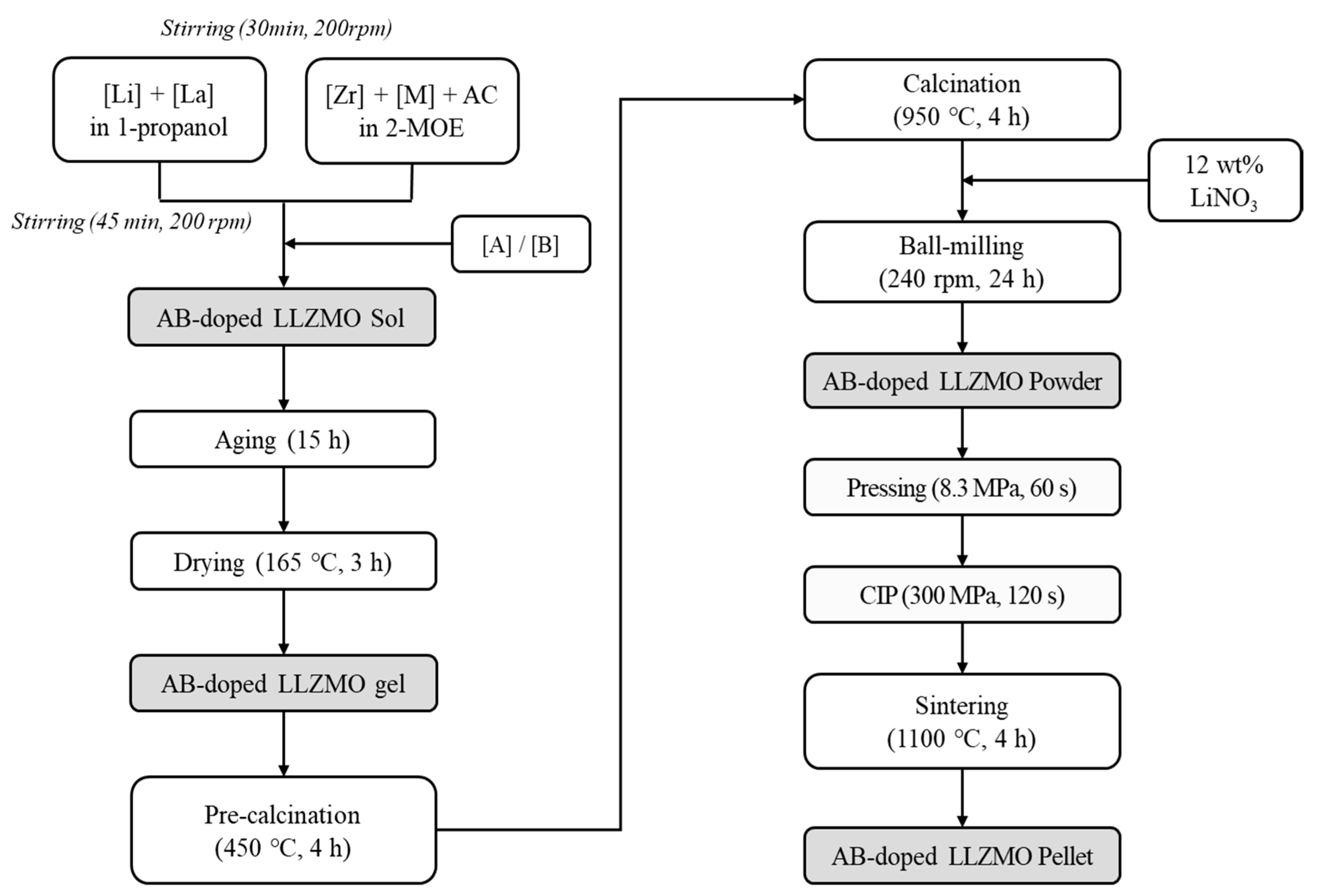
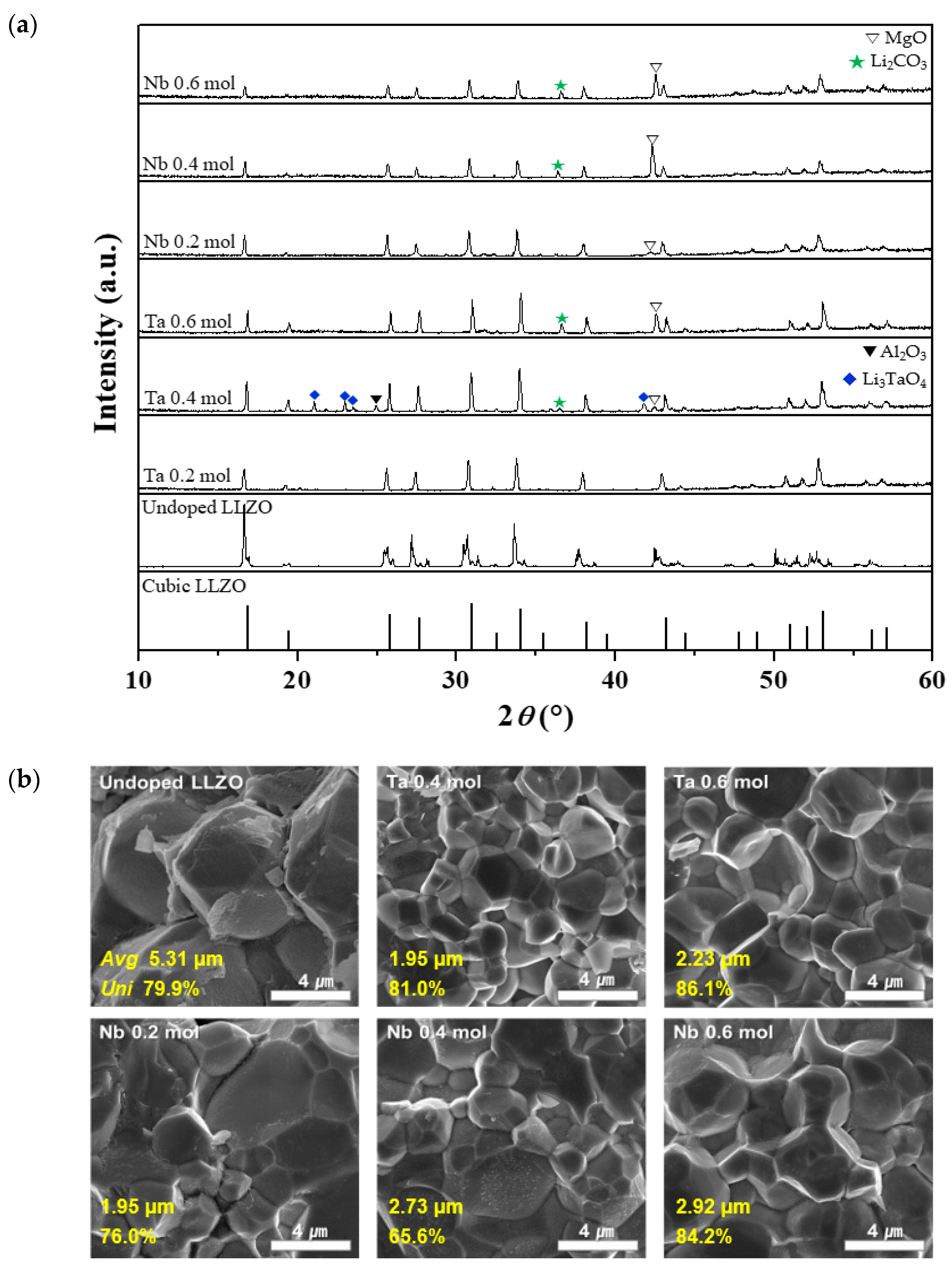
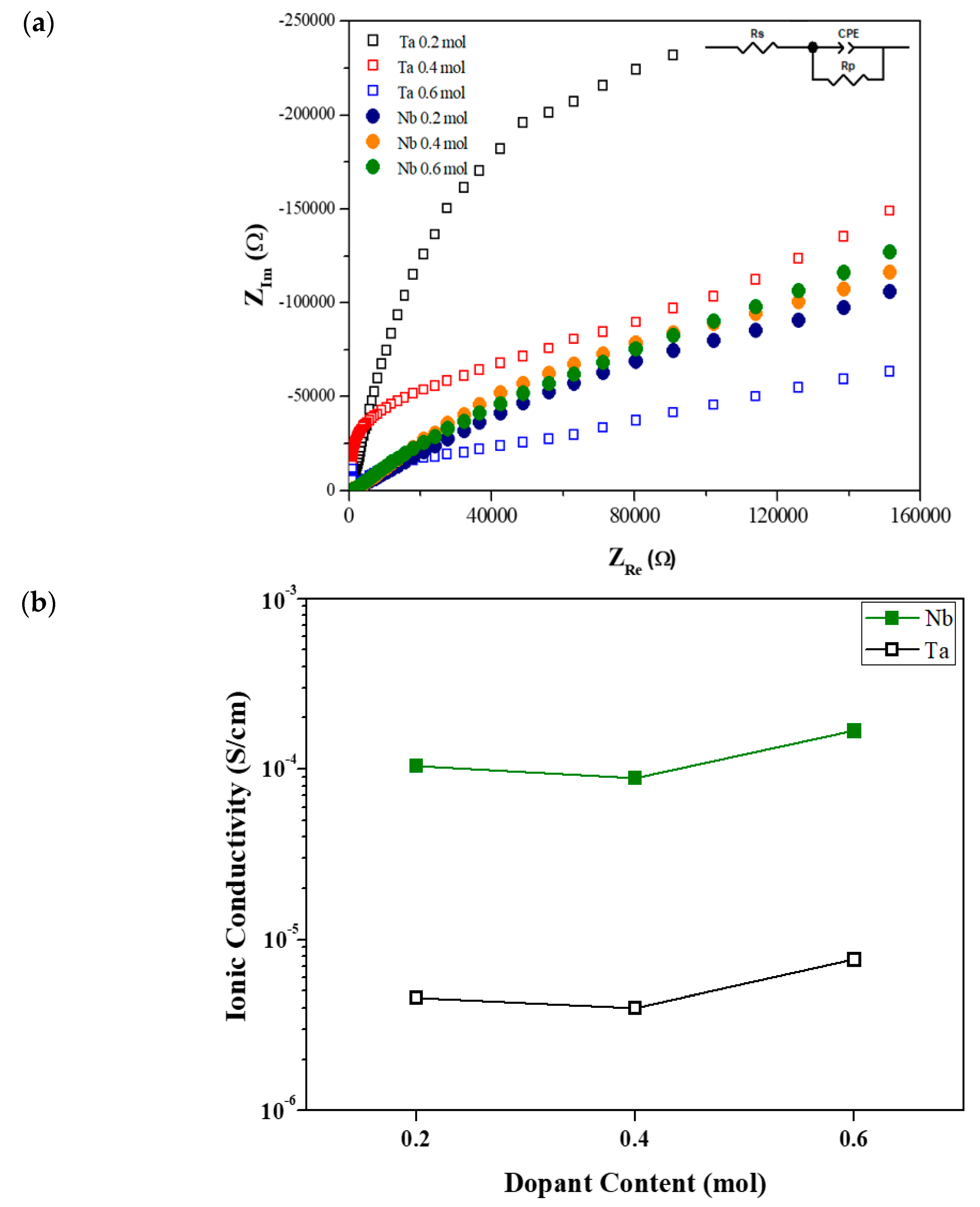
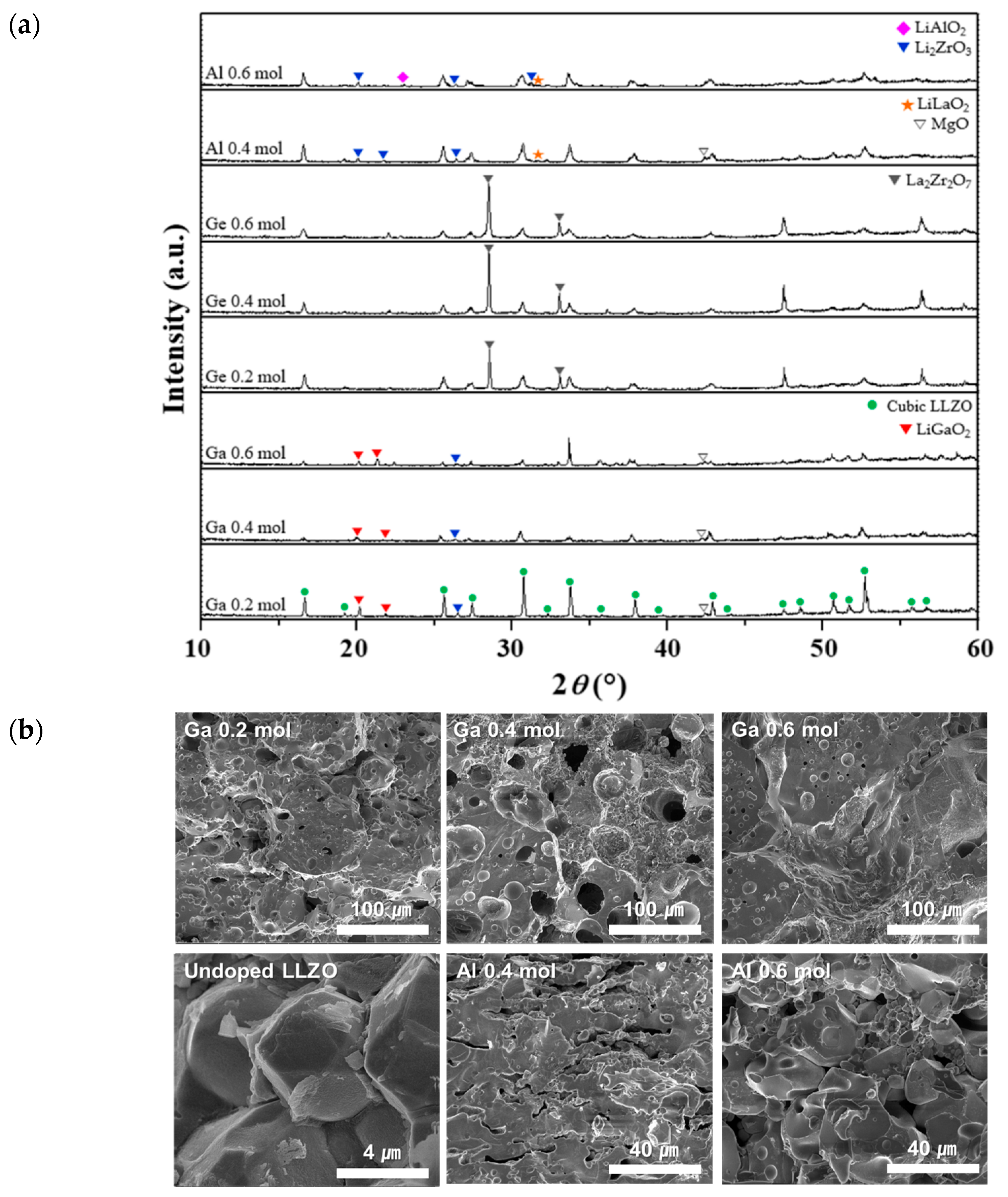

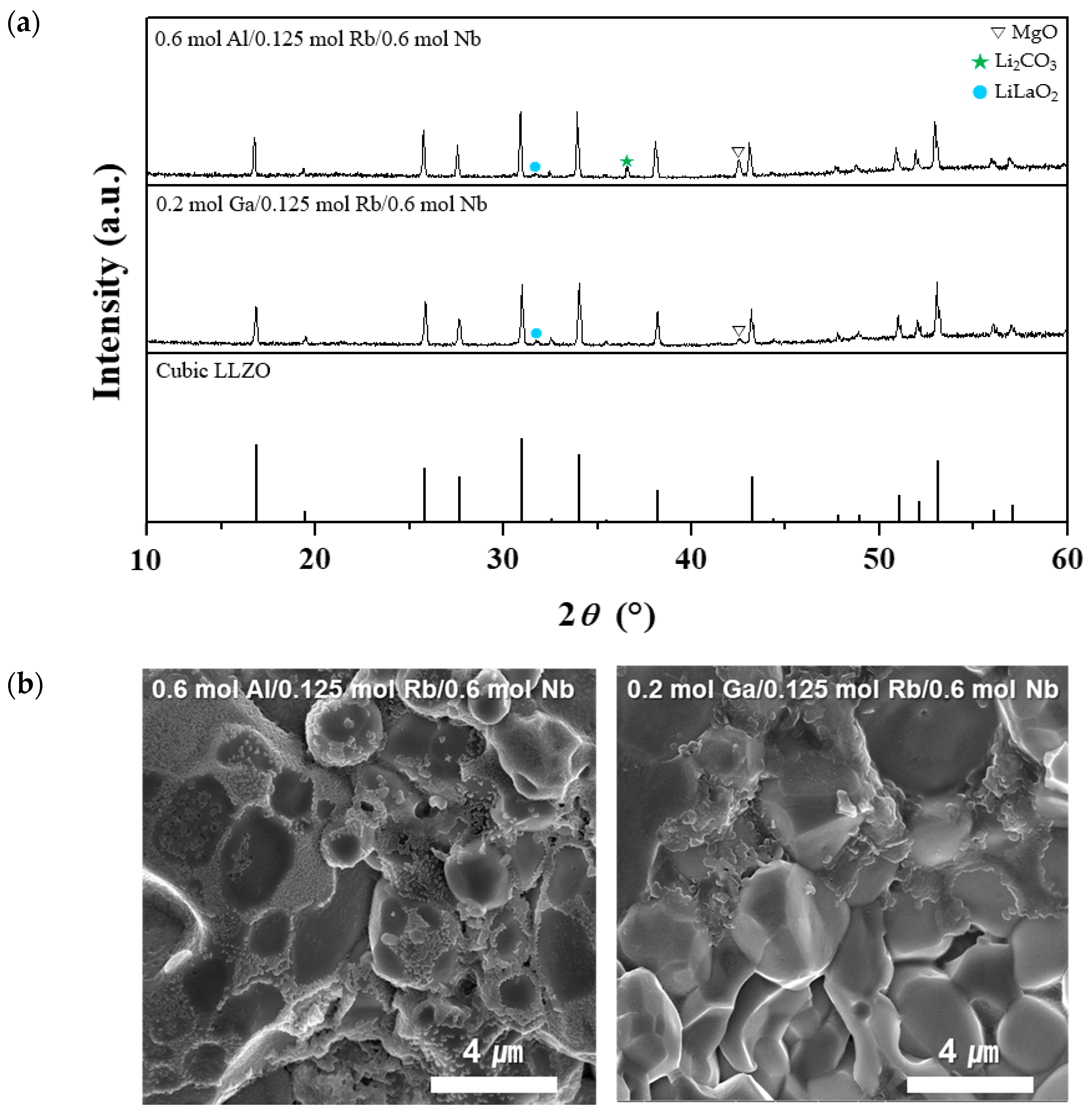

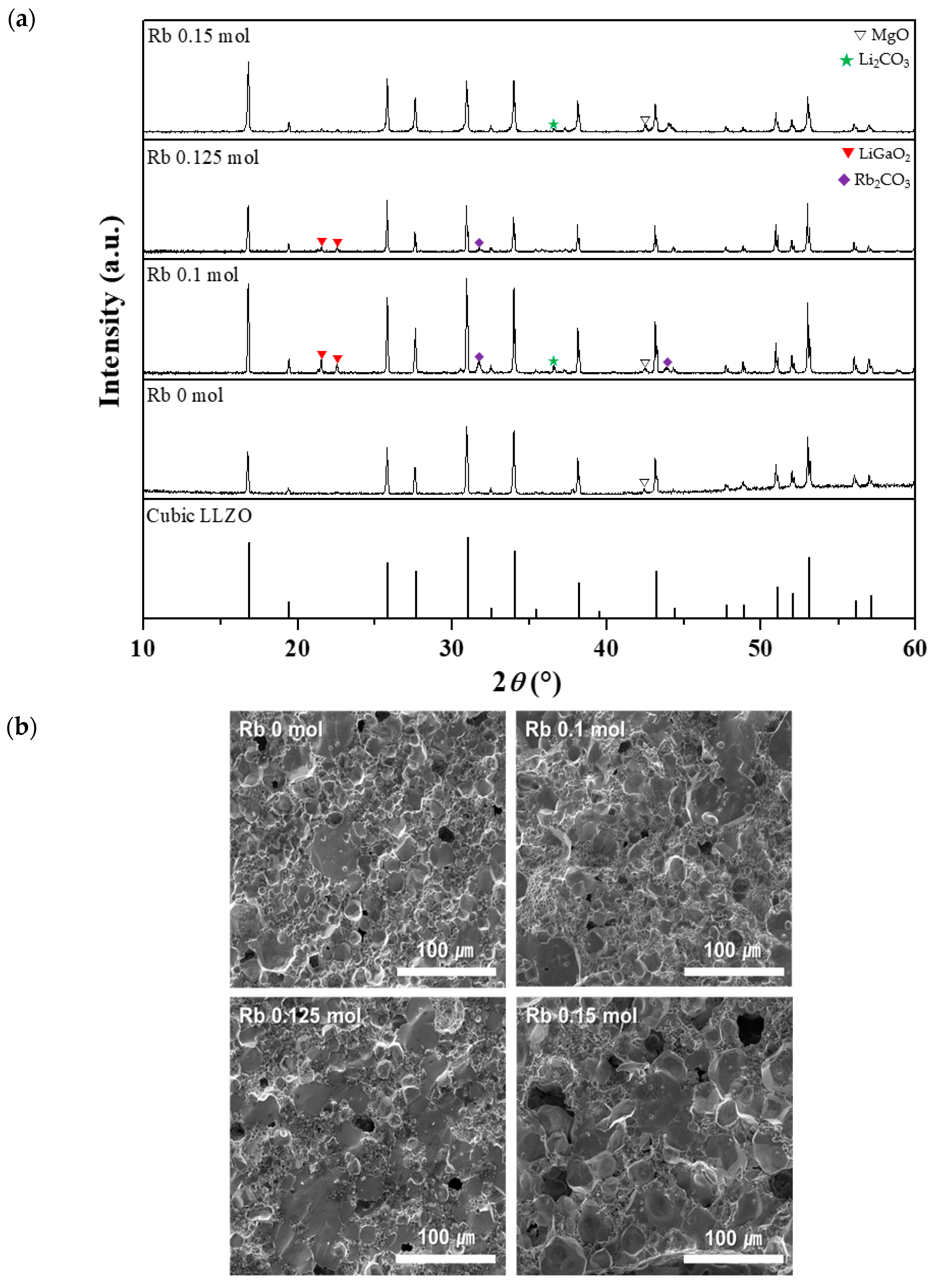
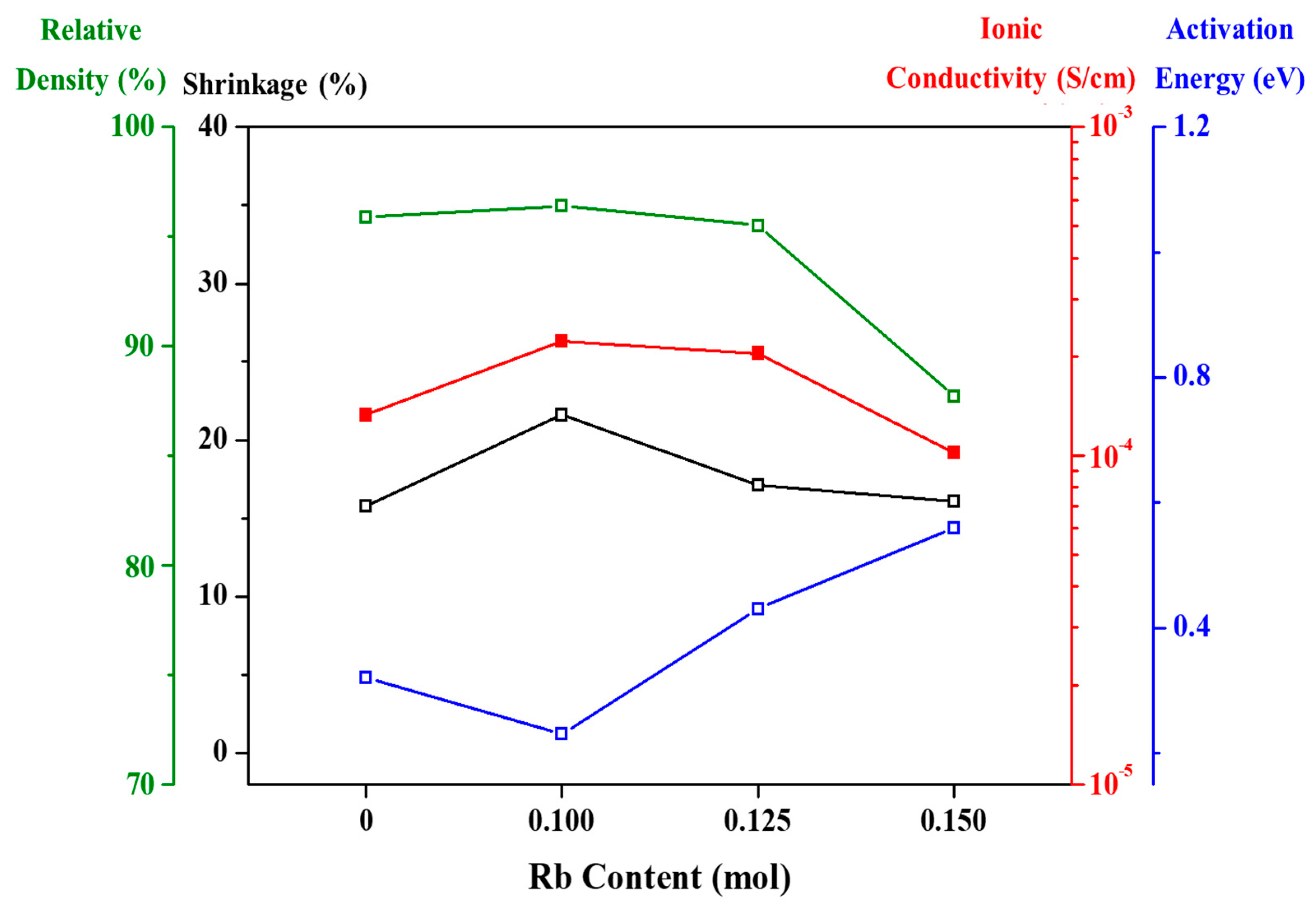
| Sample | Dopants | Ionic Conductivity (S/cm) |
|---|---|---|
| Rb0.125Li7.44La3Zr1.4Nb0.6 | 0.125 mol Rb/0.6 mol Nb | 2.129 × 10−4 |
| Al0.6Li6.84La3Zr1.4Nb0.6 | 0.6 mol Al/0.6 mol Nb | 2.024 × 10−4 |
| Ga0.2Li7.24La3Zr1.4Nb0.6 | 0.2 mol Ga/0.6 mol Nb | 1.330 × 10−4 |
| Ga0.2Rb0.125Li7.24La3Zr1.4Nb0.6 | 0.2 mol Ga/0.125 mol Rb/0.6 mol Nb | 2.053 × 10−4 |
| Al0.6Rb0.125Li6.84La3Zr1.4Nb0.6 | 0.6 mol Al/0.125 mol Rb/0.6 mol Nb | 3.956 × 10−5 |
Publisher’s Note: MDPI stays neutral with regard to jurisdictional claims in published maps and institutional affiliations. |
© 2021 by the authors. Licensee MDPI, Basel, Switzerland. This article is an open access article distributed under the terms and conditions of the Creative Commons Attribution (CC BY) license (http://creativecommons.org/licenses/by/4.0/).
Share and Cite
Kim, M.; Kim, G.; Lee, H. Tri-Doping of Sol–Gel Synthesized Garnet-Type Oxide Solid-State Electrolyte. Micromachines 2021, 12, 134. https://doi.org/10.3390/mi12020134
Kim M, Kim G, Lee H. Tri-Doping of Sol–Gel Synthesized Garnet-Type Oxide Solid-State Electrolyte. Micromachines. 2021; 12(2):134. https://doi.org/10.3390/mi12020134
Chicago/Turabian StyleKim, Minji, Gwanhyeon Kim, and Heechul Lee. 2021. "Tri-Doping of Sol–Gel Synthesized Garnet-Type Oxide Solid-State Electrolyte" Micromachines 12, no. 2: 134. https://doi.org/10.3390/mi12020134
APA StyleKim, M., Kim, G., & Lee, H. (2021). Tri-Doping of Sol–Gel Synthesized Garnet-Type Oxide Solid-State Electrolyte. Micromachines, 12(2), 134. https://doi.org/10.3390/mi12020134







